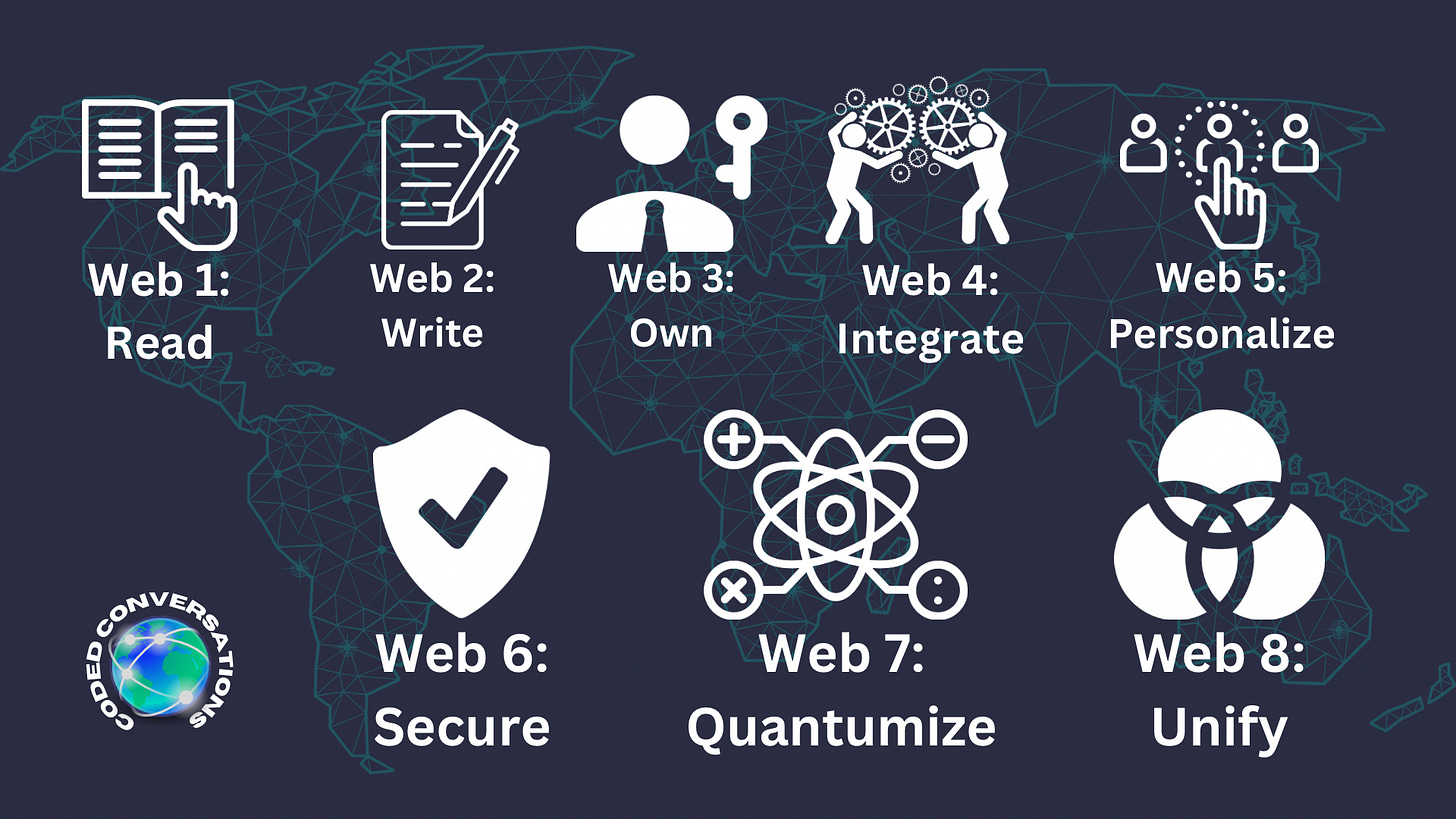The Digital Evolution: From Web 1 to Web 8 🌐🕸️🔑
Exploring the Epochs of the Internet: A Journey from Simple Browsing to Quantum Frontier
The evolution from Web 1 to Web 8 represents a thrilling saga of innovation, user empowerment, and technological breakthroughs. Each iteration of the web has not just built upon its predecessor but has also revolutionized how we interact with digital spaces, setting the stage for a future that once seemed like pure science fiction. Let's embark on a detailed odyssey through these transformative phases, unpacking their essence and envisioning where this relentless tide of progress might sweep us next.
Web 1: Read
Web 2: Write
Web 3: Own
Web 4: Integrate
Web 5: Personalize
Web 6: Secure
Web 7: Quantumize
Web 8: Unify
Web 1: The Genesis of Read-Only Era
The inception of the Internet, known as Web 1, was akin to the opening chapters of an epic novel. It was a static realm where digital pages were etched in HTML, offering a read-only interface that mirrored traditional print media. Information dissemination was unidirectional, with users as passive recipients. The simplicity of Web 1 laid the foundational stones, yet its monologue nature yearned for interactivity.
Web 2: The Dawn of Social Interactivity
As the millennium turned, Web 2 emerged, bringing the read-write era into full swing. This phase heralded the advent of social media platforms, blogs, and wikis, allowing users not just to consume content but to create it. The democratization of content creation under Web 2 fostered community, collaboration, and shared knowledge, although it also centralized data control in the hands of a few tech behemoths.
Web 3: The Revolution of Ownership
Web 3, the current frontier, is characterized by decentralization and blockchain technology. It promises a shift from the platform-centric Web 2 to a user-centric ecosystem where individuals own their data and partake in the digital economy's value creation. With the introduction of cryptocurrencies, NFTs, and DAOs, Web 3 is redefining concepts of identity, ownership, and governance in the digital sphere.
Web 4: Integration and the IoT Universe
As we peer into the horizon, Web 4 looms with the promise of seamless integration between digital and physical realms. The Internet of Things (IoT) will become the backbone of this era, with smart devices interwoven into the fabric of daily life, offering unprecedented levels of interactivity and automation. The distinction between online and offline will blur, creating a cohesive, integrated experience.
Web 5: The Age of Personalization
With the deluge of data from interconnected devices, Web 5 will usher in hyper-personalization. AI and machine learning will tailor digital experiences to individual preferences, behaviors, and needs, making the internet more intuitive and responsive. However, this will also raise pertinent questions about privacy, data security, and the ethical use of personal information.
Web 6: The Fortification of Security
As our digital and physical worlds intertwine, the sanctity of security will become paramount. Web 6 will focus on fortifying the internet's infrastructure against burgeoning cyber threats. Quantum computing will play a pivotal role in this era, offering both challenges and solutions to encryption and data protection, ensuring a safer internet for users and enterprises alike.
Web 7: Quantumization of the Web
The quantum leap into Web 7 will be marked by the integration of quantum computing capabilities directly into the web's infrastructure. This will not only revolutionize data processing speeds and encryption but also unlock new algorithms and technologies that are currently beyond our reach. Quantumization will redefine what's possible in computing, potentially making today's complex problems trivial to solve.
Web 8: The Unification Epoch
Finally, Web 8 will epitomize the ultimate convergence of all preceding layers, creating a unified, immersive digital ecosystem. This era will likely transcend beyond mere technological advancements, integrating human consciousness with digital realms, possibly through brain-computer interfaces or other yet-to-be-conceived technologies. It will represent the zenith of our digital evolution, where the boundaries between human and machine, physical and virtual, are not just blurred but eradicated.
As we stand on the precipice of these monumental shifts, it's crucial to ponder not just the technological implications but also the ethical, social, and philosophical ramifications. Each iteration of the web brings with it new opportunities and challenges, demanding a collective effort to harness its potential for the greater good while mitigating the risks.
In this relentless march towards an increasingly digital future, one thing remains clear: our journey through the iterations of the web is not just about technological prowess but about reimagining our very existence in this boundless digital cosmos. As we navigate these uncharted waters, it's imperative to steer this ship with wisdom, foresight, and a profound respect for the profound impact these changes will have on humanity.



